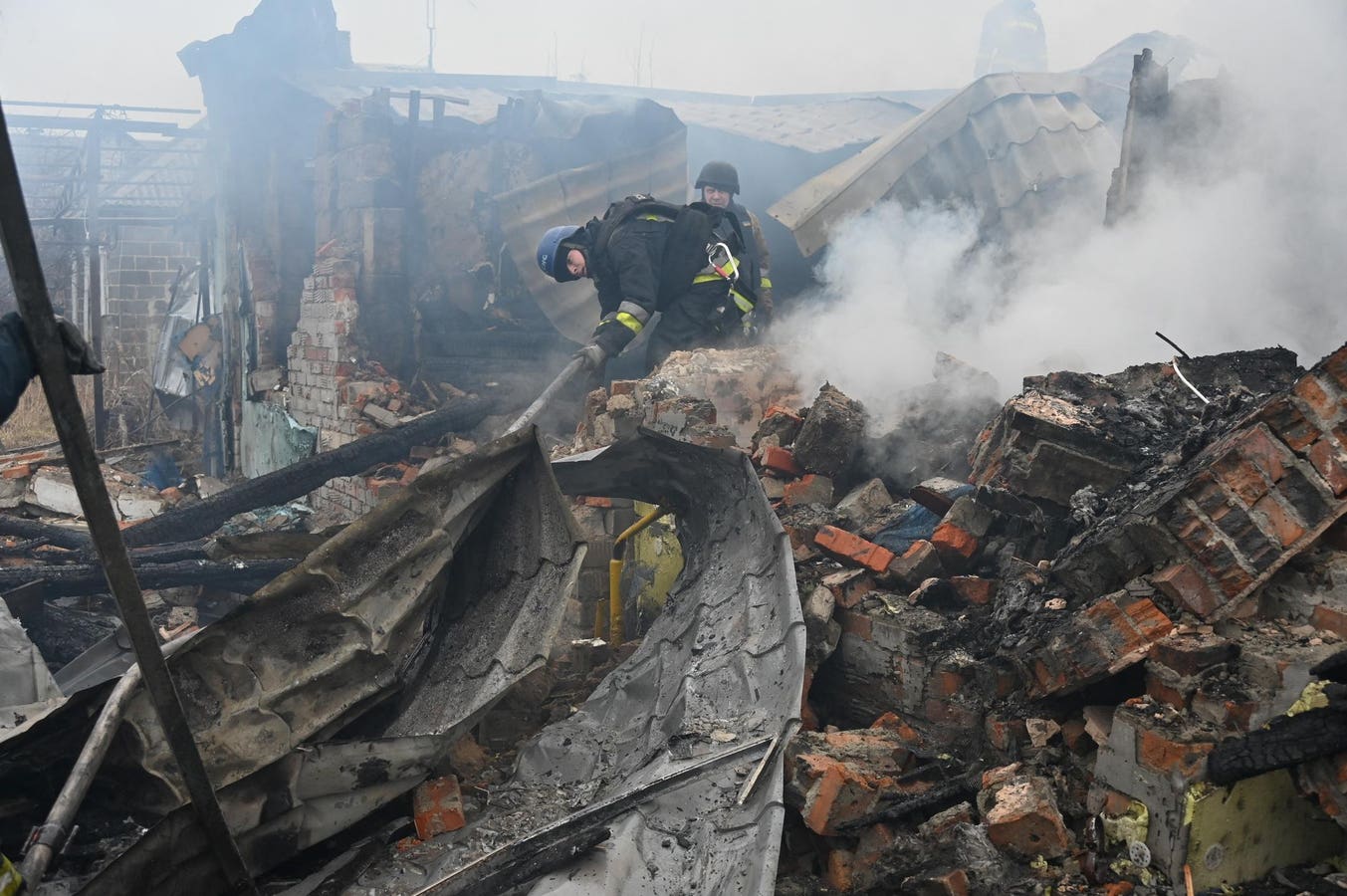Rescuers of Ukraine’s State Emergency Service attempt to put out a fire in Kharkiv on December 25, … [+] 2024, following a Russian missile attack on Christmas Day, amid the ongoing war between the two countries. (Photo: Sergey Bobok)
AFP via Getty Images
Billions of dollars of investment may be needed to rebuild Ukraine’s power systems, brought to the brink of total decimation after years of relentless attacks by Russia. This was confirmed by Moscow’s lethal attack on Christmas Day, as 2024 ended with no end in sight to nearly three years of Russian aggression.
At roughly 5:30am local time (03:30am GMT ) on December 25, Russia launched over 170 missiles and drones attacks on Ukraine, including Kalibr cruise missiles. The attack, castigated by Ukrainian President Volodymyr Zelenskyy “inhumane” given its timing, killed one person and caused widespread blackouts.
Alongside the widespread human tragedy, the Christmas Day attack, quite like many before in 2024, offered a stark view of Moscow’s desire to decimate Ukraine’s power systems and infrastructure. It’s an aim the Kremlin has largely succeeded in.
In 2022, Russia sporadically shelled Ukraine’s power distribution systems hoping for a quick and decisive end to the war. When that aim proved elusive, it switched to more targeted and precise attacks on the distribution systems in 2023, followed by strategic and heavy attacks on Ukraine’s power plants in 2024.
More Than Half Of Power Capacity Obliterated
At the start of 2024, it was largely thought that Russia had taken out nearly half of Ukraine’s power capacity, including a whopping 6GW, through its occupation of the Zaporizhzhia nuclear plant, once considered the largest power generation facility in Europe.
Subsequently, in waves of precision bombing attacks between March and May 2024, the Russians took out another 9GW of Ukrainian power generation capacity. This included thermal, hydro and solar power assets as well as numerous substations.
According to the International Energy Agency and Office of the UN Human Rights Commissioner, this left Ukraine with only around or even less than one-third of its pre-war capacity.
ForbesIndia Ups Efforts To Seek Alternatives To Russian OilBy Gaurav SharmaForbesIs The U.S. LNG Industry Witnessing Its Next Big Investment Boom?By Gaurav Sharma
Then as winter approached, Moscow stepped up its attacks on Kiev’s ability to service its power grid by another notch and rounded off its 2024 offensive for the year with the Christmas day attack.
In a bid to maintain morale, Ukraine doesn’t officially admit its power systems are on their knees. But drawing any other conclusion is hard. On December 2, even before Russia Christmas Day attack, Ukrainian Energy Minister German Galushchenko noted at a UN event that his country may have lost “around” 9GW of generating facilities in 2024 alone.
“The consequences of these attacks are very difficult for our energy system. This is equivalent to the energy consumption of some European countries, such as the Netherlands,” he added, ahead of what followed three weeks later.
Ukraine raised its electricity import capacity from the EU grid to 2.1GW from 1.7GW in December, but continues to struggle with even its capital Kiev not immune to blackouts.
Billions Needed For Reconstruction
Question is where from here and how much may be needed to rebuild and restore Ukraine’s power systems. That’s assuming an end to the conflict can be brokered by U.S. President Donald Trump over the near-term, something which may not be easy but both Putin and Zelenskyy appear to be interested in as well.
According to sources in the country, damage to Ukraine’s physical power infrastructure is thought to be in the region of $15-$20 billion. However, the financial pain doesn’t just end there.
The country’s power industry also has to contend with crippling financial losses in the region of $45-$50 billion, putting the total cost in the range of $60-70 billion. Of course, this cannot be fully tallied until the end of the conflict if and when it comes.
The last attempt to do so – by the Kiev School of Economics in August 2024 – put the figure at $56 billion. It is reasonable to assume this has been capped by several billions.
What approach to take in terms of rebuilding also divides opinion both at home and abroad. Prior to the war, Ukraine serviced nearly two-thirds of its grid by nuclear power. The post-war answer may include turning more to renewable energy.
Rebuilding would also require the return of private insurers to Ukraine for what will likely be a mammoth rebuilding effort of a broken power system. They are unlikely to do so until this unpredictable war ends. For most in the sector and beyond that cannot come soon enough.
